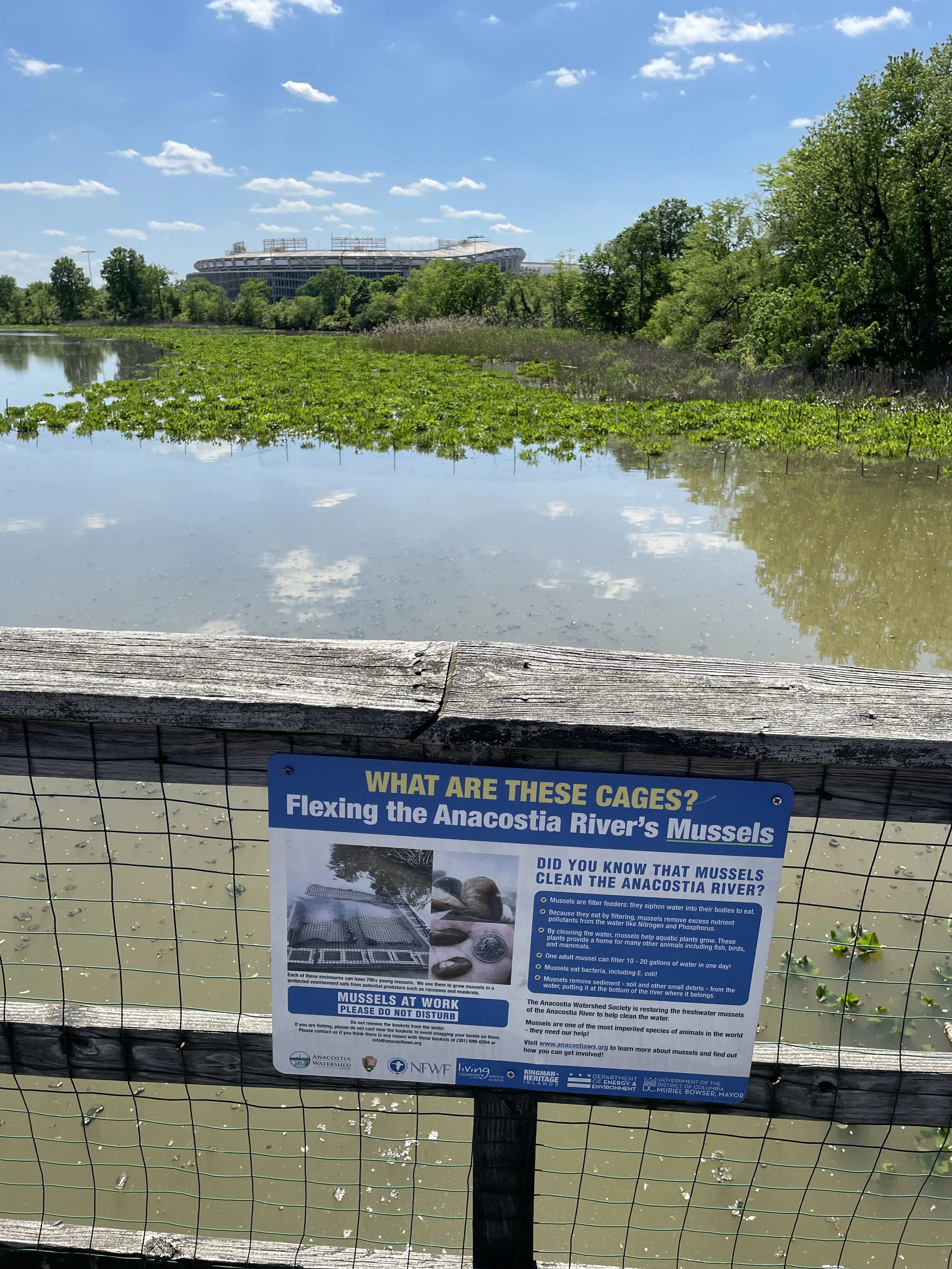Stop 2: Mussels
This page includes a self-guided tour about the mussels habitats surrounding Kingman + Heritage Islands.
This content is shared through audio files, written transcripts, and ASL videos (coming soon). We have content designed for “all ages” (which is appropriate for adults and youth alike) or “youth” (which are especially tailored for youth). Click the links below to jump to the section of your choice or scroll down the page to explore all options.
English (All Ages)
Voiced by Ariel Trahan, DOEE
Transcript
The Anacostia River has Mussel Power! And by mussels, we mean the eight different types of native mussel bivalves living in the river. These important critters filter water through their bodies to collect food, but this process also has other benefits for the river. They remove suspended sediments, nutrients and bacteria from the water column which help improves water clarity and quality.
The bivalves that were once abundant have faced challenges over the decades—pollution, habitat loss, and the encroachment of urban development had diminished their numbers. Fortunately, local environmentalists and volunteers have been working to revive the Anacostia’s mussel population. Since 2019, more than 36,000 mussels of five different species have been released into the Anacostia River with the goal to use mussel power to filter the water, improve river habitat and restore the ecosystem to a healthy, self-sustaining state. A single mussel can filter 10-20 gallons of water in one day!
For more about the hidden life of mussels and the restoration effort, visit anacostiaws.org and view their storymap.
English (Youth)
Voiced by Jorge Bogantes, Anacostia Watershed Society
Transcript
What has two shells and one foot? A mussel of course! Mussels, clams, and oysters are all bivalves- aquatic invertebrates with two shells that hinge open. The muscular foot of a mussel helps them crawl around and burrow into the muddy riverbed. Eight different kinds of freshwater mussels can be found in the Anacostia River.
Mussels can perform a very special trick. They can make the water clearer by filtering it through their bodies. Straw-like siphons suck in water, algae, sediment, and whatever else may be in the water, the mussels filter out their food from this murky soup, then shoot out the waste as a packet onto the bottom of the river. One adult mussel can filter a gallon of water each hour, imagine drinking a whole gallon jug of milk in that amount of time and turning it clear! Thanks to Mussel Power, the Anacostia River will be a healthier place for all the critters to live.
Español (Todas Las Edades)
Con la voz de Jorge Bogantes, Anacostia Watershed Society
Transcripción
¡El río Anacostia tiene el poder de los mejillones! Y con mejillones nos referimos a los ocho tipos diferentes de mejillones nativos, que viven en el río. Estos importantes moluscos filtran el agua a través de sus cuerpos para recolectar su alimento, pero este proceso también tiene otros beneficios para el río. Remueven sedimentos suspendidos, nutrientes y bacterias de la columna de agua, lo que ayuda a mejorar la claridad y la calidad del agua del río.
Estos moluscos bivalvos, que antes eran abundantes, han enfrentado muchos desafíos a lo largo de las décadas: la contaminación, la pérdida de hábitat y la expansión del desarrollo urbano han reducido su número. Afortunadamente, los ambientalistas locales y los voluntarios han estado trabajando para revivir la población de mejillones en el Anacostia. Desde 2019, se han liberado más de 36,000 mejillones de cinco especies diferentes en el río Anacostia con el objetivo de usar el poder de los mejillones para filtrar el agua, mejorar el hábitat del río y restaurar el ecosistema a un estado saludable y autosustentable. ¡Un solo mejillón puede filtrar entre 10 y 20 galones de agua en un día!
Para obtener más información sobre la vida oculta de los mejillones y los esfuerzos de restauración, visita anacostiaws.org y consulta su mapa interactivo.
Español (Para Los Jóvenes)
Con la voz de Jorge Bogantes, Anacostia Watershed Society
Transcripción
¿Qué tiene dos conchas y un pie? ¡Un mejillón, por supuesto! Los mejillones, almejas y ostras son todos moluscos bivalvos, invertebrados acuáticos con dos conchas que se abren como bisagras. El pie muscular de un mejillón les ayuda a moverse y enterrarse en el lecho lodoso del río. En el río Anacostia se pueden encontrar ocho tipos diferentes de mejillones de agua dulce.
Los mejillones tienen un poder muy especial: pueden hacer que el agua se vuelva más clara filtrándola a través de sus cuerpos. Sus sifones, que parecen popotes, succionan agua, algas, sedimentos y todo lo que haya en el agua. Los mejillones filtran su alimento de esta sopa turbia, luego expulsan los desechos como un paquete hacia el fondo del río. ¡Un solo mejillón adulto puede filtrar un galón de agua cada hora! ¡Imagina beberte una botella de leche de un galón en ese tiempo y dejarla completamente clara! Gracias al poder de los mejillones, el río Anacostia será un lugar más saludable para que todos los organismos acuáticos vivan.
American Sign Language (ASL)
Coming soon

